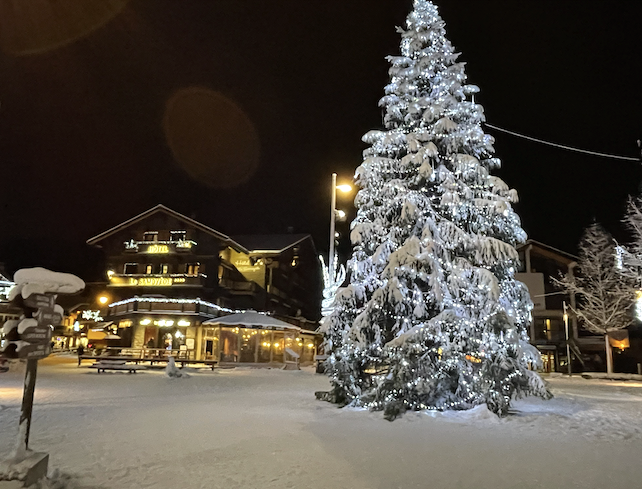
Morzine, capital of the Porte du Soleil, spans a dozen ski destinations and hundreds of kilometres of pistes along the French Swiss border. It’s just over an hour’s drive from Geneva Airport, and there’s some great skiing based around the town. What’s important is that the resort has a year-round life that includes a lot more than just sliding downhill. In these uncertain winters, that’s just as well, because the town is located at 1000 meters, which is on the low side. It means that the snow is by no means guaranteed in the valley all winter.
The big advantage for Morzine is that just above it and reached directly by lift is snow-sure Avoriaz, at 2500m the highest village in the Port Soleil, where skiing is virtually guaranteed throughout the entire season. Of course, you’ve come to Morzine to ski, but as we found out, you don’t have to do it all day long.
One morning we decided to hike, following the path of the river to get to the Nyon télépherique. It was about a half-hour’s walk in stunning scenery. Once up the mountain, it’s just a five minute cable-car ride away. The birds of prey live up beside the Pointe de Nyon mountain restaurant at the top of the cable-car. They’re housed in giant cages inside an aviary that’s well protected from the wind. Eva Meryier is the bird woman of Morzine, a 32-year-old biologist who looks after this extraordinary diverse collection of birds that live here, as well as those in her sanctuary on the shores of Lake Geneva, far below.
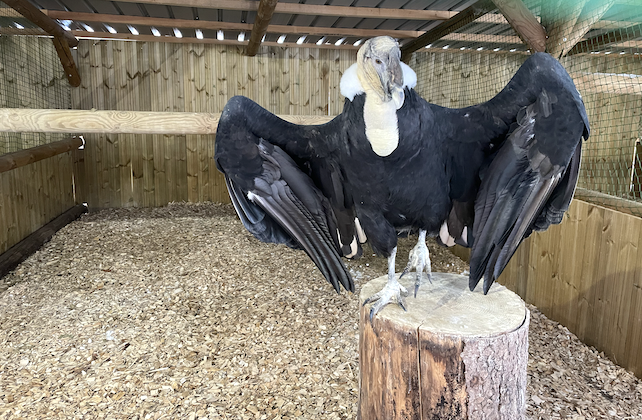
We were given thick leather gauntlets, and the birds seemed quite happy to perch on our arms, provided we kept still and didn’t try to smooth ruffled feathers. They don’t like being petted. You can even manage to support a four kilo eagle on your arm, but the South American condor weighs a mighty 13 kilos. Eva knows every one of her birds by name and looks after all the eagles here.
“We have a little bit less than ten people,” she said. “It’s a small company, and I am looking after the birds and all the collection part with the breeding and of course, the paperwork, because we have to. Here on the mountain we have only 13 birds, but actually in the park where all the birds are, we have 320 birds. We have everything from the little falcon to the big Andean condor, owls also, and we have the largest collection in Europe; we have 80 species in our park.”
We asked her what they feed on and she said: “We only have raptors, so they eat only meat and fish. To give you an idea: for a bird of almost one kilo eats only 100-120 grams. She can eat everything from mouse to beef, chicks also.
We then asked how long it takes to train a bird. She replied: “We count two years to have a completely trained bird.People working with them have to have a glove and they have also a little rope to be sure that the bird doesn’t escape if it doesn’t know the people who are holding them. When it’s with us, they are so trained and so used to us so that’s all right. And after there are some rules: you can’t pet them, they don’t like it and therefore they bite. So you have to have a special position with your glove and don’t try to touch the bird. Hopefully they are trained.
“So at the beginning it’s like with a dog or with a horse, you really have to train them. So you go farther and farther and farther and it’s always with the same person. And after, when they are completely trained, of course they can fly away for a little while because that’s what is beautiful with our work. They can escape if they want. We don’t have any link physically with them, but they always come back. They are so used to have food directly from the human that they prefer not to run after a rabbit or something. They prefer just for us to give them food. But actually we have a reintroduction program down to the lake with the white-tailed sea eagle. You have reintroduced them in the UK already, actually. And this year we have four of those little eaglets who came back to the wild and now we are sure that they know how to fish and how to hunt.
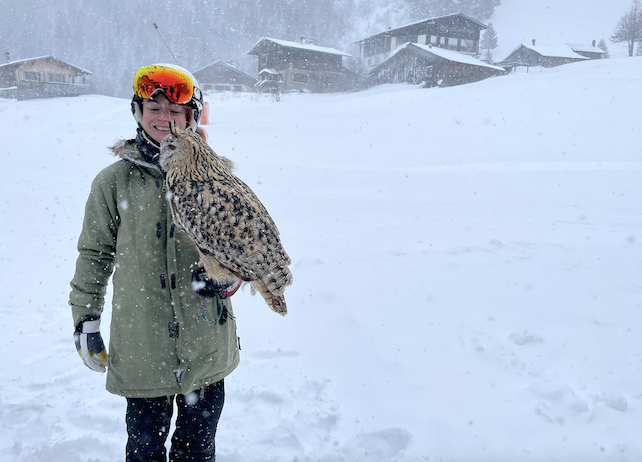
“We are lucky because we have a gondola to go directly in the restaurant. Therefore they can come whenever they want. Every day when there is good weather people can see the birds just here in front of the restaurant. It’s completely free here to the mountain. If they want to eat at the restaurant, it’s better to book. But if people just want to come to see the bird, to try to hold them it’s completely free. If you want to hold them, you just have to ask the falconer or the tourism office. And they say, ‘Ok, we want to go this day.’ And normally we have three people that can do this every day. Children can hold the birds as well, from 12 years old. Any younger and they are sometimes a little bit afraid or they are a bit too tiny.”
We are asked to hold the birds with our arm up at chest level, and it’s quite tough to hold it there for any length of time. It weighs maybe three or four kilos.
One of the owls, Ezekiel, is a first cousin of Hedwig of Harry Potter fame. Then there’s a Harris’s hawk from Latin America.
Eva says: “We propose an animation where people can fly the bird. So it has a little bit of food, and the bird goes on the glove of the person and after goes back to his falconer. And you can do it up to three times.
So if you come to Morzine the one thing you must do is have the bird experience. It’s completely free.
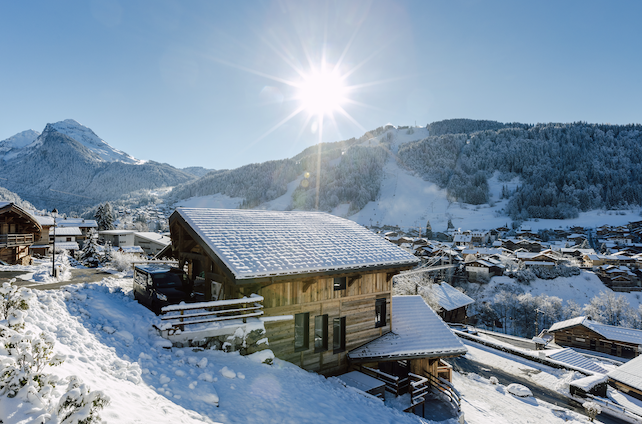
We stayed in Morzine with a chalet company called Alikats. We met up with owner Alistair Judge, who lives in the resort, and asked him how the company got its unusual name.
“I’m Al, my wife’s Kat, and it was my dad’s idea. When we were thinking through names of companies, we wanted to avoid the kind of standard mountain chalet company names that involved the word alpine or mountain or active or adventure or things like that. So we thought something that would be distinctive, and my dad came up with the idea and it stuck.
“We started in 2011 with just one chalet – a catered chalet – and we now have four catered chalets and eight self-catered chalets in the winter. This year we’re carbon neutral, which means we have offset all of the carbon emissions associated with our business. We are waste neutral, so we have offset all the waste generated by our business. We are also zero food waste, which means that we don’t put any food in the bin. It’s quite a big operation to be able to manage all that waste. So everyone who works for us, one of the reasons that they do work for us is because they are also committed to sustainability.
“We came to Morzine because we wanted to be somewhere that was a year-round working town, not just a ski resort. We wanted to be somewhere that was going to be easy for us to get back home. Yes, that’s less of an issue these days, but that was definitely part of our thinking. A lot of the ski resorts in the Tarentaise are three, three and a half hours each way. So for us, an hour and a half to Geneva makes it easy to get home. We hardly ever fly now and we try and do all of our journeys either in an electric car or occasionally train.
“Most of the chalets are either air source heat pump or they’re just pure electric. And we do have one boiler in our home that’s wood pellets – so that’s a good alternative. But most of the chalets are air source heat pump or electric. In our self-catered chalets we do meal deliveries so people can order from our kitchen, and then each day our team arrives at about four or five in the afternoon with the meal for the evening, plus reheating instructions and takes the guests about half an hour or so to heat it up and plate it up, ready to go for the evening.
“We compost all our vegetables and fruit, and then we have another system for animal-based products. So meat, fish, cheese, butter, eggs, any of the waste from those parts of the menu. It’s called a Bokashi system, which allows us to anaerobically decompose the waste down for a few weeks, at which point it then becomes safe. It’s no longer interesting to vermin, and we can then add it to the main compost pile, which means we can basically compost all of our food waste, and then that goes back into the beds to then provide nutrition for the next growing season.
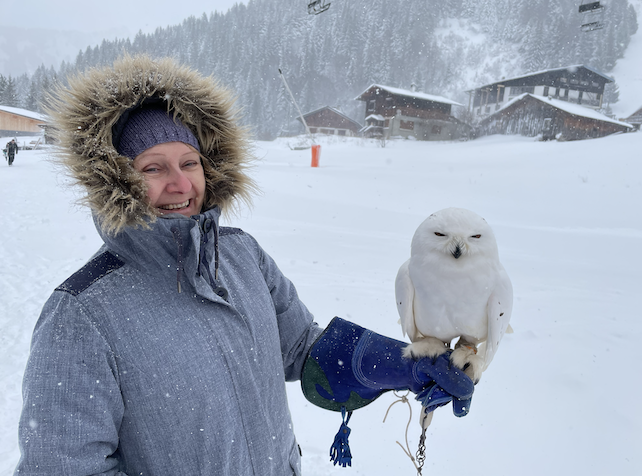
If you want to know more about the resort, visit en.morzine-avoriaz.com – and for the chalets it’s Alikats.eu A seven-night self-catered stay at Alikats Chalet Alpaga 1 is priced from €7,600 / £6,690 for 12 people or €633 / £557pp. Read more here about Les Aigles de Leman birds of prey.
Read more about Morzine here. Hear an expanded version of this post on the podcast Action Packed Travel or read about it at Actionpackedtravel.com










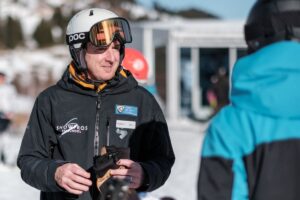

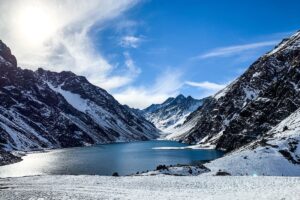
Add Comment